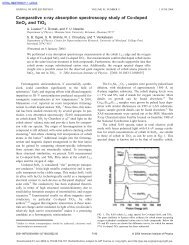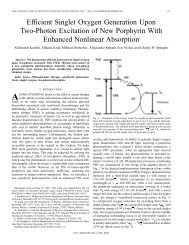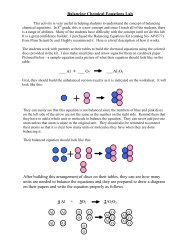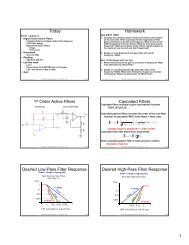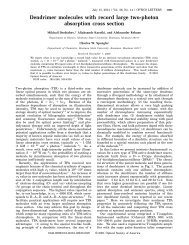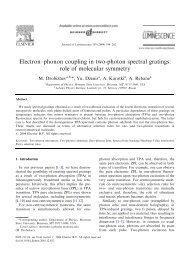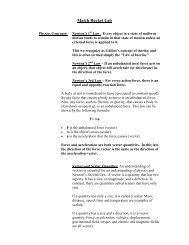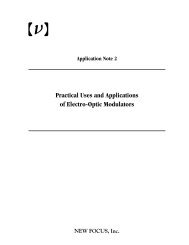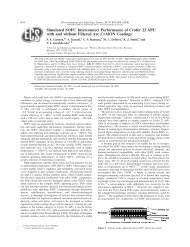Defects in inorganic photorefractive materials and their investigations
Defects in inorganic photorefractive materials and their investigations
Defects in inorganic photorefractive materials and their investigations
You also want an ePaper? Increase the reach of your titles
YUMPU automatically turns print PDFs into web optimized ePapers that Google loves.
4 B. Briat et al.<br />
b<strong>and</strong> edge, E X must be expended <strong>in</strong> order to excite a valence b<strong>and</strong> electron<br />
to the defect X 0 ,transform<strong>in</strong>git<strong>in</strong>toX − .<br />
Especially <strong>in</strong> oxide crystals, the charge carriers tend to couple strongly to<br />
the lattice. S<strong>in</strong>ce optical excitations take place under Franck-Condon conditions,<br />
i. e. with the ’lattice kept fixed’ [5, 6], <strong>in</strong> the case of strong coupl<strong>in</strong>g,<br />
thermal levels must be dist<strong>in</strong>guished from optical ones (for an example see<br />
Fig. 2): The f<strong>in</strong>al state reached by the optical transition ends <strong>in</strong> the optical<br />
level, ly<strong>in</strong>g higher than the vibrational ground state, the thermal level; for<br />
an example, see section 5. In oxide crystals energy differences between both<br />
types of levels up to about 2.3 eV [7] have been found!<br />
optical<br />
1.6 eV<br />
4+<br />
Rh<br />
3+<br />
4+<br />
3+ thermal<br />
0.95 eV<br />
Fig. 2. Discrim<strong>in</strong>ation between optical<br />
<strong>and</strong> thermal levels, exemplified for<br />
Rh 4+/3+ <strong>in</strong> BaTiO 3 (see Section 5).<br />
The elastic lattice energies, correspond<strong>in</strong>g<br />
to the electronic groundstate<br />
(upper edge of valence b<strong>and</strong>)<br />
<strong>and</strong> to the electron excited to the defect,<br />
are shown as depend<strong>in</strong>g on a<br />
configuration coord<strong>in</strong>ate Q [6]. Double<br />
arrow: transition to optical level,<br />
vertical <strong>in</strong> Q-space. Wavy arrow: vibrational<br />
transition to thermal level.<br />
Such charge transfer transitions (e.g. from a valence b<strong>and</strong> oxygen ion to<br />
a defect) or <strong>in</strong>tervalence transitions (from a defect to a conduction b<strong>and</strong> ion)<br />
usually are rather strong, because the electron moves through a considerable<br />
distance, correspond<strong>in</strong>g to a large transition moment [5]. The range of the<br />
transfer is limited by the covalent mixture between the states of the <strong>in</strong>itial<br />
<strong>and</strong> f<strong>in</strong>al ions; this is strongest between those nearest to each other. On the<br />
other h<strong>and</strong>, <strong>in</strong>ternal transitions of crystal field type occur e.g. among the d-<br />
states of one transition metal ion. For ions at crystal sites hav<strong>in</strong>g <strong>in</strong>version<br />
symmetry, such excitations thus are parity forbidden [5]. They become easily<br />
observable <strong>in</strong> situations without <strong>in</strong>version symmetry, e. g. at the tetrahedral<br />
sites of sillenite crystals. Such transitions can also be stronger, if the excited<br />
state is resonant with the conduction b<strong>and</strong>. As a general rule it can still be<br />
stated that the <strong>photorefractive</strong> effect is triggered most decisively by charge<br />
transfer or <strong>in</strong>tervalence transitions, both because they are strong <strong>and</strong> because<br />
they lead to defect photoionization.<br />
A further important consequence of lattice coupl<strong>in</strong>g is the formation of<br />
polarons. This term is related to the equivalence of correspond<strong>in</strong>g lattice sites<br />
<strong>in</strong> crystals (Fig. 3). The tunnell<strong>in</strong>g of a charge carrier between these sites competes<br />
with the lattice distortion, tend<strong>in</strong>g to break the equivalence by spon-





